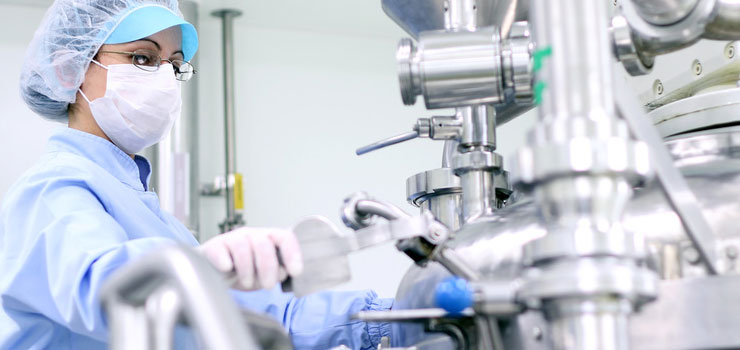Many cosmetic and health products contain different peptides and have many uses such as their potential anti-aging, body building, or anti-inflammatory properties. Research has shown that peptides can play a role in slowing down many of these issues. Many people can sometimes confuse proteins with peptides. A peptide is a large molecule. If you break protein down to a smaller piece, this would be known as a peptide. Both peptides and proteins contain amino acids, however, there is less amino acids in peptides. Peptides are amino acids joined together in a chain. When a protein is ingested, your body will break it down to single amino acids. In this article, we are discussing the modern peptide manufacturing and technology today.
What are Peptides?
Peptides are a short string of amino acids that typically contains 2-50 amino acids. Peptides tend to be more easily absorbed than proteins as they can break down more. They can go through the intestines and the skin easily and enter the bloodstream at a quick pace. Scientists are more interested in the benefits, the effects on the body, and how they may positively impact health. Peptides can be synthesized in a laboratory. Peptide synthesis is a huge market in the skin care and pharmaceutical industry. They can be purchased online at Peptides UK for research purposes.
Amino Acid Structure
In nature today there 20 amino acids. They have the exact same core as each other COOH (carboxylic acid) attached to an (NH2) amine group via a single carbon atom, called an alpha carbon. Every amino acid uniqueness comes from the function group the R side chain or the R group, these groups are attaching to the alpha-carbon. In the manufacturing of a peptide, the carboxylic acid will attach to the 1 amino acid of the amine group. This group will determine the total properties, shape, and structure within the peptide. It will then form a bond and cause a folding in the peptide. The COOH side is written and drawn on the right and the NH2 is drawn and written on the left. The COOH side is known as the C-Terminus and NH2 side is named the N-Terminus. Amino acids are required to start the peptides manufacturing process. When amino acids are used in synthesizing peptides, they need to be protected in order to prevent any reactions. You can achieve this with a common molecule called FMOC. The FMOC must be removed before attaching 2 amino acids to each other. Leaving the FMOC protecting group on one side is necessary to prevent the amino acid from coupling together.
Solid Phase Peptides Synthesis
Robert Bruce Merrifield was the first to develop the SPPS (solid-phase peptide synthesis). In the pharmaceutical industries, His technique is the standard needed for manufacturing peptides. His technique involves attaching tiny polystyrene beads to each peptide-chain. The solution will drain out through the filter while the resin retains (with the attached peptide).
Step 1 – Deprotection
The first step is the removal of the FMOC protecting group that is on the 1st amino acid in the sequence. A deprotection solution is used to complete this step. you must use 20% piperidine in the DMF solution, however, it is becoming more harder to source piperidine as it is used for the manufacturing of street-drugs. Some labs use piperazine 5% solution as an alternative. DMF solution is a lot less in price than NMP. To start the process, a vessel containing a filter is required. You need to work out the Maths, you must measure the resin to the amount exactly and add it to the vessel, and then add it to the solution. The resin amount will dedicate the number of reagents that are required and for the finished product. Let the solution rest for a short while and then drain it off. Once the deprotection is complete, it must be washed with DMF several times. The coupling attempt will be destroyed if there is piperazine leftover inside the vessel. The process is now gone from FMOC-K-resin to NH2-K-resin.
Step 2 – Coupling
The NH2-K-resin to FMOC-CK-resin. The COOH side of C must be coupled with the new deprotected NH2 side of K. You must activate the COOH first. There are many ways this can be done but the simplest is the onium salt method. You will require 2 things the hydration form of DIEA and HOBt. Use DMF solution for these, along with your amino acids and put in the correct amount into the vessel. The correct Maths is required to work out the amount for each you need to add. The ratios for the resin amount must be exact and use a three to five excess fold to make sure coupling is complete. The coupling will take several hours to complete.
Step 3 – Repeat and Cleave
When you have your resin FMOC-CK, you will need the FMOC removed from C and the Alanine coupled in. This process must be repeated several times over until the sequence is complete. When this is done, the peptide must be removed from the resin, and this is done by the cleavage process. This process uses TFA which is a potent acid that can separate the resin from the peptide. It is important to always use sufficient protection when handling TFA acid.
Crude Peptide
Once you have cleaved the resin from the peptide it will then be present in the cleavage solution. The peptide must be washed with a very cold centrifuge and ether. Once this is done, you will need to inspect the crude with a Mass-Spectrometer to see if there are any mistakes.
Revolutionary Technology
The latest and new technology and software for manufacturing therapeutic peptides is the μLOT® technology platform. This platform completely replaces the traditional large, scaled batch manufacturing. This technology provides continuous manufacturing of peptides which will enable in line process analytical technologies throughout the process providing an unprecedented level of control, quality, and a significant reduction in costs of goods. The platform was developed by a Swedish Biomimetics 3000 ltd company based in the UK.








Add Comment